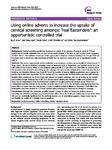Using online adverts to increase the uptake of cervical screening amongst “real Eastenders”: an opportunistic controlled trial
| dc.contributor.author | Jones, Ray | |
| dc.contributor.author | Soler-Lopez, M | |
| dc.contributor.author | Zahra, Daniel | |
| dc.contributor.author | Shankleman, J | |
| dc.contributor.author | Trenchard-Mabere, E | |
| dc.date.accessioned | 2017-03-29T09:00:26Z | |
| dc.date.available | 2017-03-29T09:00:26Z | |
| dc.date.issued | 2013-12 | |
| dc.identifier.issn | 1756-0500 | |
| dc.identifier.issn | 1756-0500 | |
| dc.identifier.other | 117 | |
| dc.identifier.uri | http://hdl.handle.net/10026.1/8724 | |
| dc.description.abstract |
BACKGROUND: Cervical screening uptake has increased as a result of occurrences of cervical cancer in TV 'soap operas' and in real life celebrities such as Jade Goody. Media analysis at the time of Jade Goody's death suggested the NHS did not take sufficient advantage of this opportunity to improve cervical screening rates. Google AdWords has been used to recruit and raise awareness of health but we were not aware of its use to supplement media events. METHODS: This was an opportunistic service evaluation to accompany a cervical cancer storyline in Eastenders (a TV 'soap opera'). We ran an AdWords campaign based on keywords such as 'Eastenders', and 'cervical cancer' in a one mile radius in East London, linked to one webpage giving details of 10 practices and other links on cervical cancer. We recorded costs of adverts and setting up the webpage. We used routine statistics from Tower Hamlets, City and Hackney, and Newham Primary Care Trusts (PCTs) of the number of smears, eligible populations, and coverage by practice by month from September 2010 to January 2012 to compare the ten intervention practices with controls. RESULTS: Eight people per day in the target area viewed the project webpage. The cost of setting up the website and running Google AdWords was £1320 or £1.88 per person viewing the webpage. Unlike Jade Goody's death, there was no major impact from the Eastenders' storyline on Google searches for cervical cancer. There was considerable monthly variation in the number of smear tests in the 3 PCTs. The AdWords campaign may have had some effect on smear rates but this showed, at best, a marginal statistical difference. Assuming a 'real' effect, the intervention may have resulted in 110 'extra' women being screened but there was no change in coverage. CONCLUSIONS: Although the Eastenders storyline seemed to have no effect on interest in cervical cancer or screening, the AdWords campaign may have had some effect. Given the small scale exploratory nature of the study this was not statistically significant but the relatively modest cost of advertising suggests a larger study may be worthwhile. An outline of a possible study is described. | |
| dc.format.extent | 117- | |
| dc.format.medium | Electronic | |
| dc.language | en | |
| dc.language.iso | eng | |
| dc.publisher | Springer Science and Business Media LLC | |
| dc.subject | Adult | |
| dc.subject | Advertising | |
| dc.subject | Early Detection of Cancer | |
| dc.subject | Female | |
| dc.subject | Health Care Costs | |
| dc.subject | Health Communication | |
| dc.subject | Humans | |
| dc.subject | Internet | |
| dc.subject | Mass Media | |
| dc.subject | Mass Screening | |
| dc.subject | Middle Aged | |
| dc.subject | Television | |
| dc.subject | United Kingdom | |
| dc.subject | Uterine Cervical Neoplasms | |
| dc.title | Using online adverts to increase the uptake of cervical screening amongst “real Eastenders”: an opportunistic controlled trial | |
| dc.type | journal-article | |
| dc.type | Controlled Clinical Trial | |
| dc.type | Journal Article | |
| plymouth.author-url | https://www.ncbi.nlm.nih.gov/pubmed/23531167 | |
| plymouth.issue | 1 | |
| plymouth.volume | 6 | |
| plymouth.publication-status | Published | |
| plymouth.journal | BMC Research Notes | |
| dc.identifier.doi | 10.1186/1756-0500-6-117 | |
| plymouth.organisational-group | /Plymouth | |
| plymouth.organisational-group | /Plymouth/Faculty of Health | |
| plymouth.organisational-group | /Plymouth/Faculty of Health/Peninsula Medical School | |
| plymouth.organisational-group | /Plymouth/Faculty of Health/School of Nursing and Midwifery | |
| plymouth.organisational-group | /Plymouth/REF 2021 Researchers by UoA | |
| plymouth.organisational-group | /Plymouth/REF 2021 Researchers by UoA/UoA03 Allied Health Professions, Dentistry, Nursing and Pharmacy | |
| plymouth.organisational-group | /Plymouth/Research Groups | |
| plymouth.organisational-group | /Plymouth/Research Groups/Institute of Health and Community | |
| plymouth.organisational-group | /Plymouth/Research Groups/Plymouth Institute of Health and Care Research (PIHR) | |
| plymouth.organisational-group | /Plymouth/Users by role | |
| plymouth.organisational-group | /Plymouth/Users by role/Academics | |
| dc.publisher.place | England | |
| dcterms.dateAccepted | 2013-03-18 | |
| dc.identifier.eissn | 1756-0500 | |
| dc.rights.embargoperiod | Not known | |
| rioxxterms.versionofrecord | 10.1186/1756-0500-6-117 | |
| rioxxterms.licenseref.uri | http://www.rioxx.net/licenses/all-rights-reserved | |
| rioxxterms.licenseref.startdate | 2013-03-26 | |
| rioxxterms.type | Journal Article/Review |


